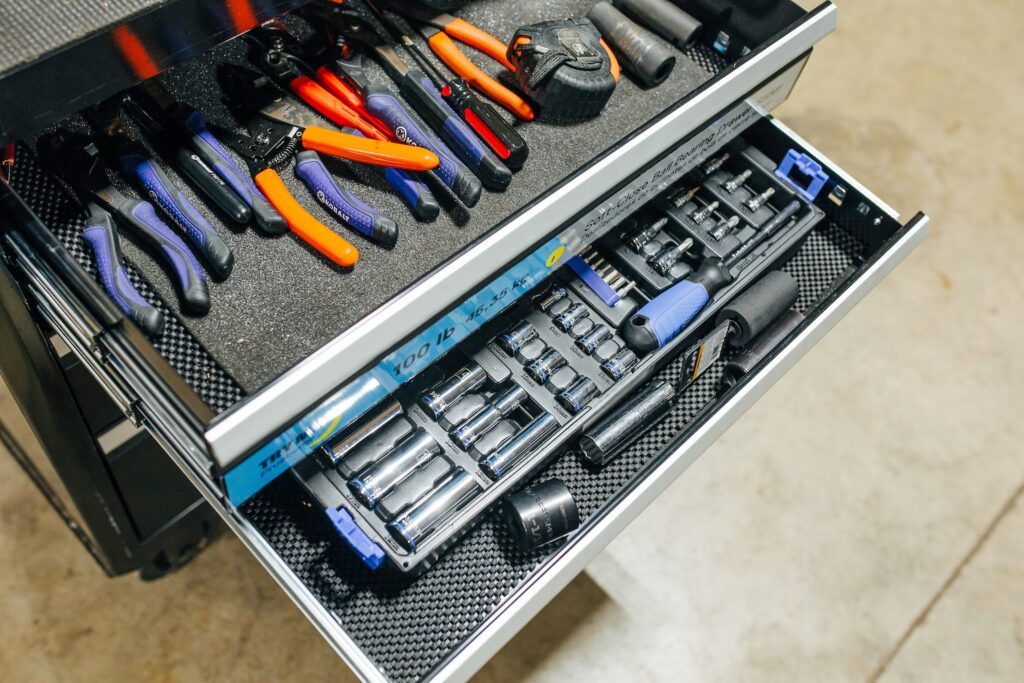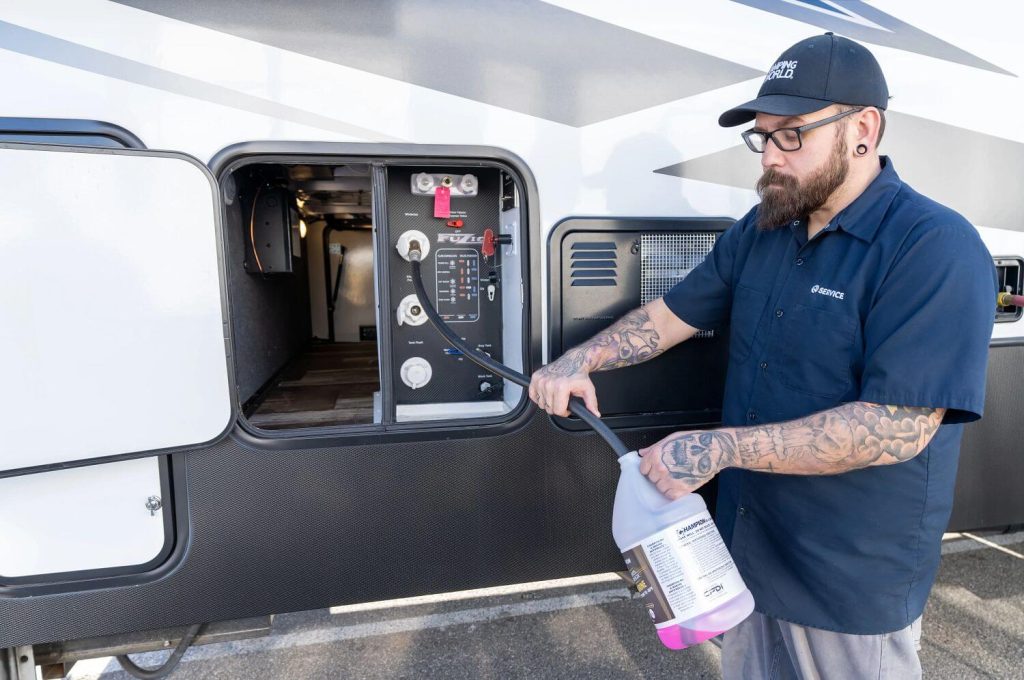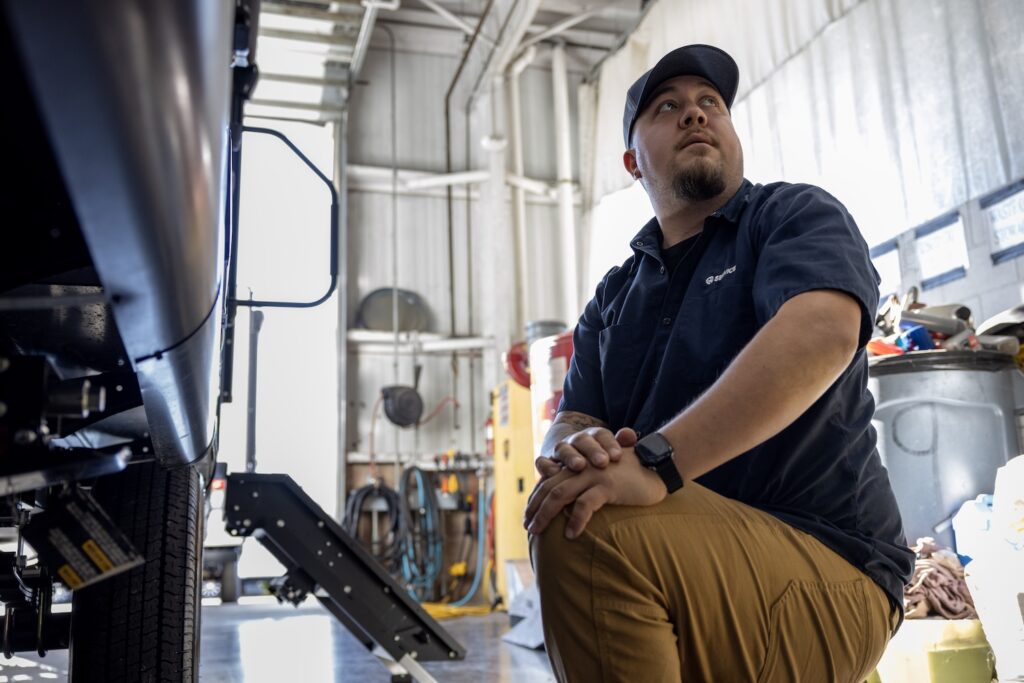WINTER IS HARD ON EVERYONE, but it can be especially tough on RVs. With the risk of freezing pipes and hidden moisture, winterizing your RV is a critical step to avoid costly repairs once temperatures start to rise in the spring. In simple terms, winterizing means preparing your RV’s plumbing and systems to withstand freezing temperatures — usually by draining or replacing water with RV antifreeze to prevent damage.
We’ve put together a complete, step-by-step walkthrough of the RV winterization process, broken down into eight easy steps. Keep in mind that every RV is slightly different — some models include extra systems like ice makers, refrigerators, or dishwashers that require special care — but these steps will cover the basics. If the process still feels intimidating, don’t worry. Your local Camping World service center can take care of it for you. But if you’re ready to tackle it yourself, use the guide below as your checklist.
Key Takeaways
- Winterization prevents costly damage. Properly draining tanks, lines, and your water heater—and adding RV antifreeze where needed—protects plumbing and fittings from freezing, cracking, and leaks.
- Every RV is a little different. Some models include additional systems, such as ice makers, dishwashers, or tankless water heaters, that require special attention. Always refer to your owner’s manual for model-specific instructions.
- You don’t have to do it alone. If DIY winterization feels overwhelming, Camping World’s certified service technicians can handle the entire process for you—saving time, stress, and future repair costs.
Table of Contents
ToggleTools Needed For Winterizing Your RV

For proper winterization, you’ll need the following tools and supplies:
- Cordless power drill with #2 square tip driver bit
- Socket wrench and 1-1/16″ socket
- Flashlight
- New anode rod or plastic plug
- 3-4 gallons of antifreeze (a little extra never hurts)
- 2 crescent wrenches or a set of open-end wrenches
- Siphoning kit (if the pump is not already equipped)
- Water heater bypass kit (if not already equipped)
- Needle-nose pliers or a screwdriver
Consider also investing in an RV winterizing kit, like we’ve outlined, that has everything you need.
Steps To Winterize Your RV

A well-winterized RV means fewer headaches, less stress, and a smoother start to camping season when spring rolls around. It also helps extend the life and performance of your RV year after year. Follow the steps below to make sure you’ve taken care of every detail.
1. Drain and Flush the Black and Gray Water Tanks
Never let wastewater sit in your RV over the winter. Stagnant waste can lead to unpleasant odors, bacterial growth, and, in freezing conditions, serious damage to your tanks and plumbing. Start by draining both tanks — always empty the black water tank first, followed by the gray water tank. This helps rinse out any residue from the sewer hose.
Once the tanks are empty, take a few extra minutes to flush and clean the black tank using a black tank flush system, a specialized cleaning wand, or a black tank cleaner designed for this purpose. This step removes leftover debris and helps prevent buildup or sensor issues while your RV is in storage.
After flushing, make sure the valves are completely closed and your sewer hose is drained and stored properly. A clean, dry waste system will make your spring de-winterization much easier — and much less smelly.
Learn more about RV holding tank maintenance.
2. Drain and Flush the Water Heater
Next, you’ll need to remove any remaining water from your RV water heater. Leaving water inside can be a costly mistake — as temperatures drop, that water can freeze and expand, potentially cracking the tank or damaging fittings. Start by turning off the water heater and allowing it to cool completely. Never attempt to drain it while it’s hot or under pressure. Once cooled, disconnect power (both electric and propane, if applicable) to ensure the heating element doesn’t turn on while empty.
Connectthe city water to your RV with the water supply turned off. Then use a socket wrench to carefully remove the drain plug or anode rod, and open the pressure relief valve to let air flow through and water drain out smoothly. Once drained, replace the anode rod loosely (or store it for inspection and replacement later).
Technician Tip: If your RV has a tankless water heater, the process is a little different. These systems usually don’t have a large reservoir to drain, but you’ll still need to blow out or bypass the lines to ensure no water remains inside. Always follow your manufacturer’s instructions for winterizing a tankless system to prevent internal damage.
3. Bypass the Water Heater
Before adding antifreeze to your RV, ensure that you bypass the water heater. You don’t want any antifreeze making its way into the water heater. Many RVs come with a bypass valve already installed, while others may require a manual setup.
To locate the water heater, find the water heater service door on the RV’s exterior and then trace the connection inside your RV. Usually, there’s an access panel inside that you will need to remove. Using your drill and square-tip driver bit, remove the panel to access the valves and adjust them to bypass the water heater properly.
4. Drain the Fresh Tank and Low Point Drains
Before removing the drain plug, make sure all water pressure is off — disconnect city water and turn off your water pump. Then open the fresh water tank drain valve or plug and allow the tank to empty completely. Opening the faucets inside your RV will help air enter the system and speed up the flow.
Once the tank is empty, locate and open your low-point drains (usually one for hot water and one for cold) to remove any remaining water in the lines. When everything is drained, close all faucets and reinstall the drain plugs.
5. Locate the Water Pump
Attach the siphoning kit, or if your RV is equipped, locate the siphoning hose and place it inside your gallon of antifreeze. Open the valve. Turn on the water pump to allow the antifreeze to start flowing through the water system.
6. Open External Faucets and Valves on the Outside of the RV
Beginning with the lowest valve and working your way up, open low-point drain valves or loosen the low-point drain plugs to allow water to run out. Continue until the water turns pink (this indicates that the antifreeze is thoroughly making its way through the pipes), then close the valves or retighten the plugs. Turn on any outside showers or exterior faucets, running one side (hot or cold) until it runs pink, then close it and run the other.
7. Open Internal Faucets, Showers, and Toilets
Repeating the process from step six, run the faucets inside (kitchen, bathroom, and showers), starting with one side until it runs pink, then closing it and running the other side. Then repeat this process for all toilets until you see the antifreeze.
8. Pour Antifreeze Down P-Traps
After that, you should pour some additional antifreeze down the drain of each sink, shower, and RV toilet to ensure the exterior termination pipes don’t freeze over winter. With all that done, you should double-check that the water heater’s heating element is turned off and all faucets are closed.
Schedule an RV Winterization Service

If the steps above sound too complicated, or they’re just not something you want to do this season, no worries–we understand. Simply visit your local Camping World location and let our highly qualified service professionals take care of it for you. Doing it yourself can be rewarding, but paying professionals to handle your home on wheels is never a bad idea.
For other winterization tips and tricks, check out your RV’s owner’s manual. It’s common for different classes of RVs and various appliances to have additional needs before you can adequately store your RV for the winter. After all, a successful winterization leads to a successful spring when RV season rolls around again.
Preparing your RV for different seasons helps protect its integrity and prevents future repairs. Check out some of the following resources to learn more:
- How to Dewinterize Your RV
- RV Air Conditioner Cleaning
- RV Furnace Repair and Maintenance
- Tips for Cleaning Black Streaks from RV
Do you have any questions about winterizing your RV? Leave a comment below and we’ll respond ASAP!
Author
-

For nearly 60 years, Camping World has made RV ownership and the outdoor lifestyle safe, fun, and easy.
View all posts









At my hot water tank do I close the valve for the cold also so no antifreeze goes in to that hot water container
Hi Brenda,
Can you confirm if you’re winterizing an RV with a tankless or a standard tanked water heater?
Excellent step-by-step guide for winterizing an RV! The detailed instructions and visuals make the process seem much less daunting. Properly preparing your rig for winter storage is crucial to avoid costly repairs later. I’ll be bookmarking this article as my go-to reference.
So glad you found it useful Gary!
Should cupboard doors be left open?
Hi Paula!
I doesn’t hurt to leave cabinets and what not open just for airflow. If any moisture was in those area’s it could start to mold or create an unwanted odor. Hope that helps!
Found in step 2 detail:
“Once drained, turn the water pressure on and flush out the sediment for 2-3 minutes.”
Hi Brad, please see my reply to your other comment for clarity, but don’t hesitate to let us know if you have other questions about the process!
Why “Hook up city water to your RV with the water turned off” in step 2?
2. Drain and Flush the Water Heater
You’ll also need to get the water out of your water heater. This means you need to turn it off and let it cool down, and not be under pressure. Hook up city water to your RV with the water turned off. From there, you can use your socket wrench to remove the drain plug or anode rod and open the pressure relief valve.
This will let the water drain out. Don’t drain the water heater if it’s hot or has pressure built up. Wait until the temperature and pressure come down. Once drained, turn the water pressure on and flush out the sediment for 2-3 minutes. Remove the anode rod if old and leave it out during winter; make a note to install a new one in the spring.
Hi Brad,
The city water will be used to flush the water heater tank once it’s drained. Hooking it up with it off just means to leave the spigot at the city water connection off until the tank is initially drained. Hope that clarifies things, but let us know if you have any follow up questions!
Should I drain the antifreeze or blow it out of the lines or is the idea to keep the system full of fluid. Also some treads suggest undoing the lines in and out of the pump. Seems like it could get messy. I’m in Central Alberta so -40 is highly possible.
No need to drain.
Hi Joe,
You should definitely leave the antifreeze in the lines, but you’ll need the proper extreme duty RV antifreeze rated for those frosty temperatures. That antifreeze should last 2-5 years in the sealed lines. The water hear, fresh tank drain, and holding tanks should be left empty. When winterizing, care must be taken to ensure that the antifreeze is pumped through the city inlet, water pump, low point drains, outside kitchens, outside shower, shower heads, filter housings, ice makers, dishwashers, washing machines, accumulator, screen filter bowls, toilets, tank flushes, etc.
Winterizing isn’t the quick, simple job it once was. If you have any reservations, your local Camping World can provide a Complete or Deluxe Winterize for them. Here’s where you can find a service center near you: https://rv.campingworld.com/rv-service-maintenance#js-anchor-locations
I drained all the water out of the tanks then put three gallons of antifreeze in the fresh water tank. I turned on the water pump and nothing came out of the faucets. Where do people in the videos get the water that flows from the faucets before it turns pink if everything is empty?
My winterizing process is somewhat less complicated. Mid October, load up DPtag, hook up one of the Jeeps, shut down bricks’n’sticks, fuel up, take I-70 West to I-35 @KCMO, hang a lazy louie, set cruise on 70, out run the cold. Reverse process about April, or May, or maybe NOT. Easy, peasy, works every year. We don’t camp. We LUXURIATE!!!!!
There seems to be disagreement over whether you open a faucet or close the faucets after winterization. You said, close all faucets. Is it o.k. To leave a faucet or two open for possible expansion? Thanks!
Thanks this was very helpful.
What do we do to keep our RV from freezing during the winter when in use!! We use ours years around.
If I use an air compressor and blow the water out of my lines is it necessary to hook up to my water pump and run antifreeze through my lines. If I blow out the water and pull my water heater plug then run antifreeze down my P traps will I be ok,
I keep an electric heater on in my garage bathroom to keep pipes from freezing over the winter. Is it possible to do the same in the RV.
If all (or nearly all) the water has been drained from the system, why is antifreeze necessary? It seems like even if a little bit of water were left in the system somewhere, it would have room to expand in a mostly empty system.
Where is the switch to turn on and off the therma heat as stated in the owner manual? Class C forester.
I have food trailer with a 20gal fresh water tank, a 50 gal black water and an instant propane water heater. We will be using the water on several occasions maybe every other week or so but while it sits in between events how do we keep the water from freezing? Is this something we will have to do everytime we get ready to store it for a week a or two?
I might be camping in the winter if the temperatures stay above freezing. Is there anything I can do to prevent my pipes from freezing in between camping trips?
Can I winterize the tank and still go camping if I don’t use the water or toilet?
If i use an air compressor to blow all the water out of the lines, do I still need to put antifreeze in them?
What do you charge to winterize a thor ace 27.1
Hi Annamarie!
I’d recommend contacting your local Camping World service center directly: https://rv.campingworld.com/rv-service-maintenance
They can give you pricing and info on our two winterization packages!
Hi Judy! If water flows from the faucets before it turns pink (or the color of the antifreeze you use), that tells me there was still water in the system. That might not be a significant issue if the ratio of water to antifreeze is roughly 50/50. But some antifreeze bottles are pre-mixed (i.e., already a 50/50 solution). Did you use a pre-mixed solution or a 100% antifreeze?
Also, are your faucets and low point drains closed again before you turn on the water pump to circulate the antifreeze? If the system is open (i.e., a faucet or low point drain is open), it will be harder for your water pump to build pressure to circulate antifreeze. Feel free to follow up if you have additional questions. I’d love to make sure your RV’s plumbing is safe as we move through these winter months!
Thanks for sharing Scott!
You’re spot on about the possibility of residual water remaining in the lines when using air to blow them out. Antifreeze is a safe bet for long-term winterization.
Great call Joey!
I’ve personally taken this approach myself over the last few years. Do you ever head to any of these snowbird destinations?
https://blogcw.local/the-rv-life/where-to-go/unsung-snowbird-destinations-for-rvers/
I used air pressure for years in Virginia; my first two years in Colorado I lost waters pumps. The technician advised me that blowing out the lines leaves some residual water, even condensation from extreme temperature changes can freeze, expand and blow seals in the water pump. Anti-freeze is a cheap solution when considering the cost of replacing broken pumps. I also leave all the knife switches on the tank outlets open. Even when drained, condensation can build and cause freezing that will prevent the knife switches from opening/closing. (We take out our fifth wheel and the end of February and de-winterize that day before our departure for warmer climes)
I wondered the same thing. It works for our sprinkler system, and I wouldn’t think it would be difficult to do it. Drain the water lines and blow out the gray water drains. It might cause some issues with the gray water tank smell getting into the trailer past a cleared P trap. At a minimum, it would drastically reduce the need for antifreeze. Black water tank would have to stay with antifreeze treatment, so I guess that actually would fill all the lines anyway.
Hi Mike!
Great question. Let’s clarify:
If you do a basic winterizing, it’s okay to leave the valves open on the faucet and low-point drains. If you do a complete or deluxe winterize with antifreeze, it’s best to leave them closed, so they don’t drip antifreeze on the plastic sinks or shower pans. The antifreeze will get slushy but not freeze solid to be able to expand and crack a fixture. We’ve never seen damage from closing the faucets with antifreeze in the system. If the RV has been properly blown out there is no reason not to close the faucets, as there would be no water to expand and damage them.
Hopefully that clears things up, but let us know if you have additional questions!
What fo you charge to winterize class c 26foot.
Hi Gary, reach out to the service department, and they’ll be able to give you a quote! https://rv.campingworld.com/service
Yep! The storage space underneath the RV is often called a basement. This is where I’d put a small space heater if the plumbing runs through there (most of the time it does). It really depends on the unit. Some travel trailers won’t really have a basement like a motorhome or a fifth wheel.
What do you mean the basement of my RV? Do you mean underneath the RV?
Hey, Paul. Yeah, you can use a small space heater in the basement of your RV that should help keep your pipes warm enough to keep from freezing. Also, there are heating pads you can add to your holding tanks.
Hi Warren, I’m not familiar with your particular model. I’d say give the nearest Camping World dealership a call. They’ll be able to help you out
Hey Don, If the RV is in freezing temperatures you may have to or find a way to keep the tanks and water lines warm. You can buy heating pads for your tanks that should help keep them from freezing.
Hi Sue, if you’re not actually using the water system I would think you’d be okay. The other option is to get heating pads for the tanks and make sure the lines and tanks never get cold enough to freeze.